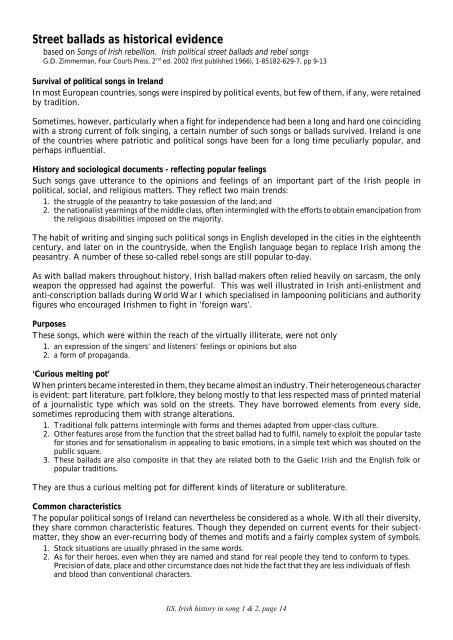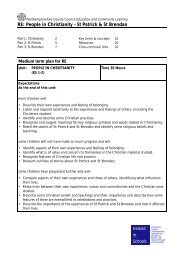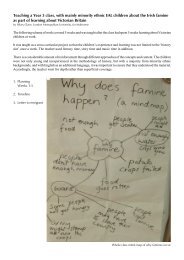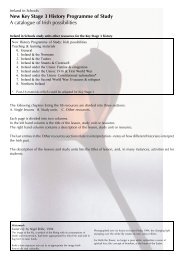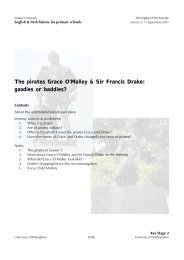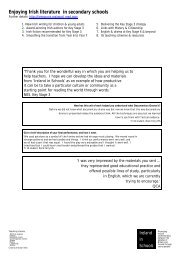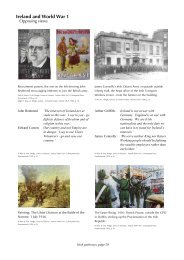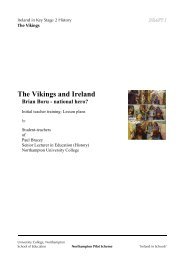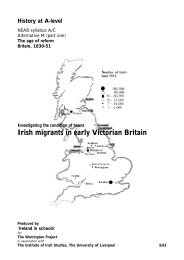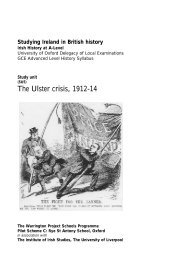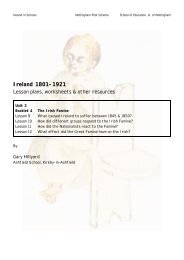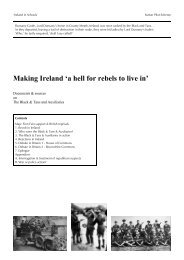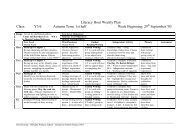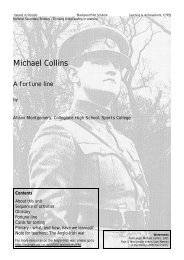E:\Irish music\A4 Irish history in song 1 & 2.wpd - Ireland in Schools
E:\Irish music\A4 Irish history in song 1 & 2.wpd - Ireland in Schools
E:\Irish music\A4 Irish history in song 1 & 2.wpd - Ireland in Schools
Create successful ePaper yourself
Turn your PDF publications into a flip-book with our unique Google optimized e-Paper software.
Street ballads as historical evidencebased on Songs of <strong>Irish</strong> rebellion. <strong>Irish</strong> political street ballads and rebel <strong>song</strong>sG.D. Zimmerman, Four Courts Press, 2 nd ed. 2002 (first published 1966), 1-85182-629-7, pp 9-13Survival of political <strong>song</strong>s <strong>in</strong> <strong>Ireland</strong>In most European countries, <strong>song</strong>s were <strong>in</strong>spired by political events, but few of them, if any, were reta<strong>in</strong>edby tradition.Sometimes, however, particularly when a fight for <strong>in</strong>dependence had been a long and hard one co<strong>in</strong>cid<strong>in</strong>gwith a strong current of folk s<strong>in</strong>g<strong>in</strong>g, a certa<strong>in</strong> number of such <strong>song</strong>s or ballads survived. <strong>Ireland</strong> is oneof the countries where patriotic and political <strong>song</strong>s have been for a long time peculiarly popular, andperhaps <strong>in</strong>fluential.History and sociological documents - reflect<strong>in</strong>g popular feel<strong>in</strong>gsSuch <strong>song</strong>s gave utterance to the op<strong>in</strong>ions and feel<strong>in</strong>gs of an important part of the <strong>Irish</strong> people <strong>in</strong>political, social, and religious matters. They reflect two ma<strong>in</strong> trends:1. the struggle of the peasantry to take possession of the land; and2. the nationalist yearn<strong>in</strong>gs of the middle class, often <strong>in</strong>term<strong>in</strong>gled with the efforts to obta<strong>in</strong> emancipation fromthe religious disabilities imposed on the majority.The habit of writ<strong>in</strong>g and s<strong>in</strong>g<strong>in</strong>g such political <strong>song</strong>s <strong>in</strong> English developed <strong>in</strong> the cities <strong>in</strong> the eighteenthcentury, and later on <strong>in</strong> the countryside, when the English language began to replace <strong>Irish</strong> among thepeasantry. A number of these so-called rebel <strong>song</strong>s are still popular to-day.As with ballad makers throughout <strong>history</strong>, <strong>Irish</strong> ballad makers often relied heavily on sarcasm, the onlyweapon the oppressed had aga<strong>in</strong>st the powerful. This was well illustrated <strong>in</strong> <strong>Irish</strong> anti-enlistment andanti-conscription ballads dur<strong>in</strong>g World War I which specialised <strong>in</strong> lampoon<strong>in</strong>g politicians and authorityfigures who encouraged <strong>Irish</strong>men to fight <strong>in</strong> ‘foreign wars’.PurposesThese <strong>song</strong>s, which were with<strong>in</strong> the reach of the virtually illiterate, were not only1. an expression of the s<strong>in</strong>gers’ and listeners’ feel<strong>in</strong>gs or op<strong>in</strong>ions but also2. a form of propaganda.‘Curious melt<strong>in</strong>g pot’When pr<strong>in</strong>ters became <strong>in</strong>terested <strong>in</strong> them, they became almost an <strong>in</strong>dustry. Their heterogeneous characteris evident: part literature, part folklore, they belong mostly to that less respected mass of pr<strong>in</strong>ted materialof a journalistic type which was sold on the streets. They have borrowed elements from every side,sometimes reproduc<strong>in</strong>g them with strange alterations.1. Traditional folk patterns <strong>in</strong>term<strong>in</strong>gle with forms and themes adapted from upper-class culture.2. Other features arose from the function that the street ballad had to fulfil, namely to exploit the popular tastefor stories and for sensationalism <strong>in</strong> appeal<strong>in</strong>g to basic emotions, <strong>in</strong> a simple text which was shouted on thepublic square.3. These ballads are also composite <strong>in</strong> that they are related both to the Gaelic <strong>Irish</strong> and the English folk orpopular traditions.They are thus a curious melt<strong>in</strong>g pot for different k<strong>in</strong>ds of literature or subliterature.Common characteristicsThe popular political <strong>song</strong>s of <strong>Ireland</strong> can nevertheless be considered as a whole. With all their diversity,they share common characteristic features. Though they depended on current events for their subjectmatter,they show an ever-recurr<strong>in</strong>g body of themes and motifs and a fairly complex system of symbols.1. Stock situations are usually phrased <strong>in</strong> the same words.2. As for their heroes, even when they are named and stand for real people they tend to conform to types.Precision of date, place and other circumstance does not hide the fact that they are less <strong>in</strong>dividuals of fleshand blood than conventional characters.IiS, <strong>Irish</strong> <strong>history</strong> <strong>in</strong> <strong>song</strong> 1 & 2, page 14


